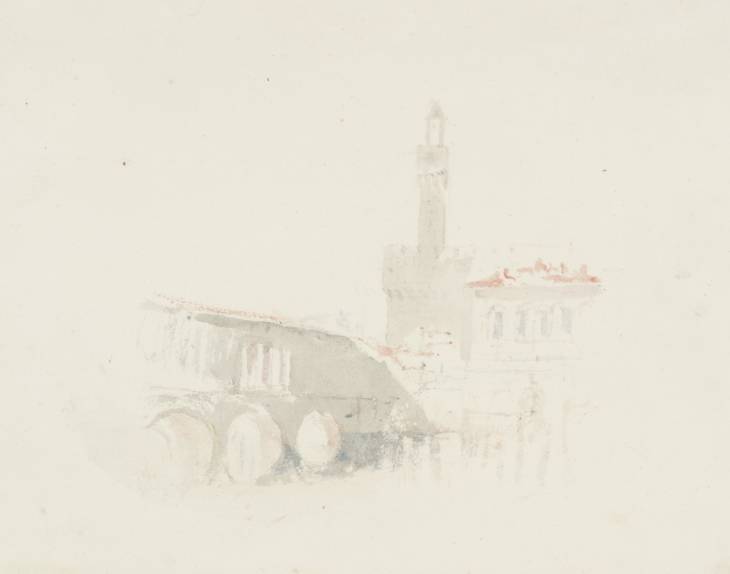Joseph Mallord William Turner The Ponte Vecchio, Florence; ?Vignette Study for Rogers's 'Italy' c.1826-7
Joseph Mallord William Turner,
The Ponte Vecchio, Florence; ?Vignette Study for Rogers's 'Italy'
c.1826-7
Joseph Mallord William Turner 1775–1851
The Ponte Vecchio, Florence; ?Vignette Study for Rogers’s ‘Italy’ circa 1826–7
D27612
Turner Bequest CCLXXX 95
Turner Bequest CCLXXX 95
Pencil and watercolour, approximately 115 x 140 mm on white wove paper, 191 x 243 mm
Inscribed by John Ruskin in red ink ‘(95’ bottom right
Stamped in black ‘CCLXXX 95’ bottom right
Inscribed by John Ruskin in red ink ‘(95’ bottom right
Stamped in black ‘CCLXXX 95’ bottom right
Accepted by the nation as part of the Turner Bequest 1856
Exhibition history
1878
[Oxford Loan Collection], University of Oxford, 1878–1916 (128 and 96b).
1991
Turner: The Fourth Decade: Watercolours 1820–1830, Tate Gallery, London, January–May 1991 (55, reproduced).
References
1878
Catalogue of Sketches by Turner Lent by The Trustees of the National Gallery to the Ruskin Drawing School, Oxford, London 1878, nos.128 (1st edition), 96b (2nd edition), as ‘Florence’.
1903
E.T. Cook and Alexander Wedderburn (eds.), Library Edition: The Works of John Ruskin: Volume I: Early Prose Writings 1834–1843, London 1903, pp.233, 244.
1904
E.T. Cook and Alexander Wedderburn (eds.), Library Edition: The Works of John Ruskin: Volume XIII: Turner: The Harbours of England; Catalogues and Notes, London 1904, pp.380–1.
1906
E.T. Cook and Alexander Wedderburn (eds.), Library Edition: The Works of John Ruskin: Volume XXI: The Ruskin Art Collection at Oxford, London 1906, p.214.
1909
A.J. Finberg, A Complete Inventory of the Drawings in the Turner Bequest, London 1909, vol.II, p.895, as ‘Florence’.
1966
Adele Holcomb, ‘J.M.W. Turner’s Illustrations to the Poets’, unpublished Ph.D thesis, University of California, Los Angeles 1966, p.52, reproduced fig.14.
1983
Cecilia Powell, ‘Turner’s vignettes and the making of Rogers’s “Italy” ’, Turner Studies, vol.3, no.1, Summer 1983, pp.6, 13 note 6.
1984
Cecilia Powell, ‘Turner on Classic Ground: His Visits to Central and Southern Italy and Related Paintings and Drawings’, unpublished Ph.D thesis, Courtauld Institute of Art, University of London 1984, p.519 note 56.
1987
Cecilia Powell, Turner in the South: Rome, Naples, Florence, New Haven and London 1987, p.134, reproduced fig.140, as ‘Florence’.
1991
Ian Warrell, Turner: The Fourth Decade: Watercolours 1820–1830, exhibition catalogue, Tate Gallery, London 1991, p.55 reproduced and in colour pl.55, p.21.
1993
Jan Piggott, Turner’s Vignettes, exhibition catalogue, Tate Gallery, London 1993, p.96.
This is an unfinished design for a vignette that Turner produced to illustrate a description of Florence in Rogers’s Italy. It presents a different scene from the one that was eventually published in Italy, which shows a view of Florence seen from Fiesole (see Tate D27673; Turner Bequest CCLXXX 156). Here, Turner experiments with a composition that showcases some of the city’s salient architectural and cultural landmarks: the Ponte Vecchio, the Palazzo Vecchio, and the Uffizi. These subjects are perfectly suited to the content of Rogers’s verses on Florence, which primarily celebrate the city’s artistic treasures and cultural heritage. Turner had visited the Uffizi Gallery in 1819 and again in 1828, when he may have been inspired by Titian’s Venus of Urbino to paint his Reclining Venus of 1828 (Tate N05498).1
The evolution of Florence is not the only example in the Italy series of an unconventional preliminary composition being abandoned for a more familiar view; a similar shift can be observed in the preparatory and final designs that Turner produced for Venice (see Tate D27519; Turner Bequest CCLXXX 2 and Tate D27710; Turner Bequest CCLXXX 193). Rogers’s tastes were at least partly responsible for the preponderance of traditional compositions. Rogers’s biographer, P.W. Clayden, says of the illustrations: ‘Everything was done under Rogers’s own constant direction and supervision. He chose the subjects, suggested the character of the pictures, superintended their execution, and made the illustrations almost as much his own as the letter-press they adorned.’2 The two men appear to have had a good working relationship throughout the production of Italy and they may have agreed that the conventional Italian views such as those shown in Florence, Venice, and Rome, Castel San Angelo (see Tate D27677; Turner Bequest CCLXXX 160) were best suited to the overall tone and aesthetic of Rogers’s verses.3
There are ruled pencil lines partially visible along all four sides of sheet, framing the vignette. Cecilia Powell has noted such lines were often made by the engravers during the process of squaring-up the designs for reduction.4
Verso:
Inscribed by an unknown hand in blue pencil ‘222’ bottom centre
Meredith Gamer
August 2006
How to cite
Meredith Gamer, ‘The Ponte Vecchio, Florence; ?Vignette Study for Rogers’s ‘Italy’ c.1826–7 by Joseph Mallord William Turner’, catalogue entry, August 2006, in David Blayney Brown (ed.), J.M.W. Turner: Sketchbooks, Drawings and Watercolours, Tate Research Publication, December 2012, https://www

